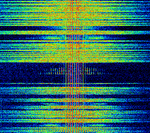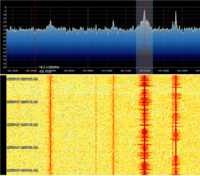NFM Voice
Used in analog walkie-talkies and communication systems. In addition, old cordless phones and baby monitors transmit unencoded NFMNarrowband Frequency Modulation voice. These older devices are most commonly found in the 49 MHzMegaHertz (MHz) 10^6 Hz Part 15 band 49.82 MHzMegaHertz (MHz) 10^6 Hz – 49.9 MHzMegaHertz (MHz) 10^6 Hz region. FCC type accepted 25 channel analog cordless phones can be found in the 43-49.98 MHzMegaHertz (MHz) 10^6 Hz range. They can also be found in the 27 MHzMegaHertz (MHz) 10^6 Hz, 40 MHzMegaHertz (MHz) 10^6 Hz, 864 MHzMegaHertz (MHz) 10^6 Hz and 902-928 MHzMegaHertz (MHz) 10^6 Hz regions.
Newer devices utilize the DECT protocol, which is harder to decode.
Frequencies[edit]
27 MHzMegaHertz (MHz) 10^6 Hz CB (Europe), 30-50 MHzMegaHertz (MHz) 10^6 Hz, 137-174 MHzMegaHertz (MHz) 10^6 Hz, 350-512 MHzMegaHertz (MHz) 10^6 Hz
Amateur: 29.5-29.7 MHzMegaHertz (MHz) 10^6 Hz, 52-54 MHzMegaHertz (MHz) 10^6 Hz, 144-148 MHzMegaHertz (MHz) 10^6 Hz, 420-450 MHzMegaHertz (MHz) 10^6 Hz (USA) or 430-450 MHzMegaHertz (MHz) 10^6 Hz (Canada) or 430-440 MHzMegaHertz (MHz) 10^6 Hz (Europe), 902-903/927-928 MHzMegaHertz (MHz) 10^6 Hz (ITU Region 2), 1240-1300 MHzMegaHertz (MHz) 10^6 Hz
NOAA Weather Radio and Weatheradio Canada: 162.4000 - 162.5500 MHzMegaHertz (MHz) 10^6 Hz, 7 channels on 25 kHzKiloHertz (kHz) 10^3 Hz channel steps
PMR (Europe): 446 MHzMegaHertz (MHz) 10^6 Hz
FRS/GMRS (Americas): 462.5500 - 462.7250 MHzMegaHertz (MHz) 10^6 Hz and 467.5500 - 467.7250 MHzMegaHertz (MHz) 10^6 Hz, 28 channels on 12.5 kHzKiloHertz (kHz) 10^3 Hz channel steps
UHFUltra High Frequency (300-3000 MHz) CB (Australia/New Zealand): 476.4250-477.4125MHz, 80 channels with 12.5kHz steps
Audio Samples[edit]
| NOAA NFMNarrowband Frequency Modulation Weather |
|---|
Decoding Software[edit]
GQRX, GnuRadio "nbfm receive", anything.


